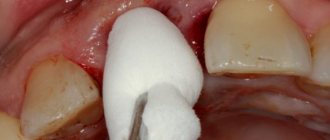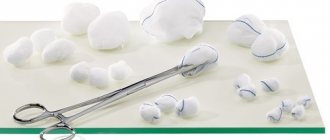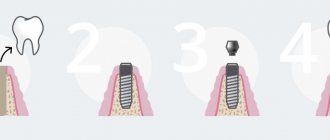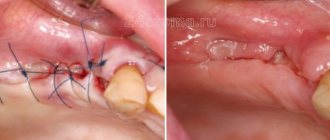23.12.2020 43779
Anyone, sooner or later, may need a tooth extraction. This occurs due to its severe destruction, progression of the inflammatory process and other reasons.
Typically, doctors use removal surgery only as a last resort, when other means are ineffective. It is important to understand that the procedure is a surgical operation that must be carried out carefully and in compliance with all safety requirements.
In this material we will touch on an important issue - the rehabilitation period. We will talk about how long it takes for the gums to heal after tooth extraction, and what rules should be followed to prevent complications from occurring. Compliance with simple safety requirements will not only significantly speed up recovery, but also ensure the safety of your health.
How much does tooth extraction hurt the gums?
Assessing how severe the harm from tooth extraction will be is not always easy. Sometimes removal can take much longer and have a very negative impact on the condition of a person’s gums. And here it doesn’t really matter which doctor performs the procedure - there are many potential complications.
Among the most notable factors of injury are the following:
- Rupture of the ligaments and muscles that hold the tooth. They help the tooth stay inside the socket and not become loose over time.
- Tissue damage. We are talking about both periodontal and periodontal tissues. They can heal for quite a long time.
- Impact on the vascular system and nerves. Serious damage to blood vessels and nerves can usually occur. It is precisely because of the likely contact of blood with pathogenic bacteria during the recovery period that it is important to observe hygiene standards.
When going through the recovery process, you should be prepared for the fact that signs characteristic of inflammation will be observed for some time. In this case, swelling may appear, the temperature of the tissue at the site of removal may increase, and bleeding may occur. Pain also becomes a frequent companion during the recovery period.
In our clinic, removal is performed as carefully and carefully as possible. The extensive experience of doctors allows us to minimize tissue damage and reduce trauma. We will also answer the question of how long it takes for gums to heal and how to properly care for the socket so that it heals as quickly as possible.
Prevention
There are a number of actions that the patient must take immediately after this procedure and which will allow him to prevent possible complications.
- After the extraction, the patient needs to tightly compress the dentition. This is necessary in order to press firmly on the tampon placed in the wound.
- The medicine should not be removed by yourself.
- The hole should not be touched with your tongue or fingers. This is necessary so as not to accidentally damage the blood clot that has formed in the wound.
- If the patient experiences unbearable pain, it can be relieved with the help of analgesics that were recommended by a specialist. The dosage should also be prescribed by the doctor, since each patient reacts individually to the tooth extraction procedure.
- During the period until the wound is completely healed, the patient should stop smoking. This process greatly interferes with the normal healing of the hole.
- If the patient detects symptoms of complications, then, without delay, he should consult a dentist.
The patient needs to be aware of symptoms that may indicate the occurrence of suppuration or any other complications. Having noticed any of the signs, the patient should immediately contact a specialist for advice and subsequent treatment. We must not forget that only proper maintenance of oral hygiene and compliance with all the necessary rules will help the wound heal much faster. You will find out the proportions of soda solution for rinsing teeth in the article.
The main stages of socket healing after tooth extraction
It is impossible to clearly predict how long the hole will take to heal. The individual characteristics of the human body, the type of tooth and the characteristics of the operation are of great importance. Typically, it takes more time to restore a hole after the removal of a tooth with a large number of roots and the need for additional manipulations - creating an incision in the gum and others.
In some cases, during the removal process, crumbling and splitting may occur - then the gums will be injured even more.
Conventionally, several main stages of healing can be distinguished:
- Reduced bleeding. Depending on the characteristics of the patient’s body, the gums should stop bleeding after 2-3 hours. Some people take a little longer. If the bleeding does not stop, you should immediately consult a doctor. But this is a rare occurrence unless the patient has problems with blood clotting.
- Formation of a blood clot in the socket. It is very useful because it does not allow bacteria that cause diseases to enter the wound. You cannot remove such a clot - bleeding will open, there is a high risk of inflammation and resumption of bleeding.
- Appearance of a film on the clot. This is a white coating of the epithelium. Gradually it covers more and more space. Between the fourth and seventh day after surgery, the entire clot should turn white.
- Formation of epithelial tissue. Occurs between 20 and 24 days after surgery. The gums from the outside will be the same as next to healthy teeth - color, texture.
When the patient follows the dentist’s instructions and treats the hole carefully, there should be no complications or any problems.
After three days
The blood clot begins to change and thicken. Gray and white fibrin stripes appear on it, after which the formation of new gum tissue begins. Painful sensations may still occur. But they are much weaker and have a pulling character. The patient may experience bad breath. This is considered normal and is due to the formation of a blood clot. Failure to brush your teeth also leads to the formation of bacteria and an unpleasant odor.
To rinse the mouth, you must use special solutions recommended by your doctor. The appearance of pain from touching the gums, increased pain during eating, serves as a signal for the need to return to the dentist's office. If the tissue of the edges of the hole has acquired a red tint, you should also immediately consult a specialist.
Features of the gum restoration process
Sometimes patients wonder if there are any differences in the recovery process, depending on what kind of surgery was performed on the patient. The answer is yes, there are such features. Let's consider three main variants of the situation.
Standard tooth extraction
When a person is healthy, the removal went well, and the tooth itself was not classified as complex, the restoration process begins immediately.
The recovery process takes longer if the tooth was large and a wide wound appears in its place. In this case, the dentist will apply stitches. They last on fabric for 7-8 days, sometimes less or more. Throughout this time, you may feel pain or signs of an inflammatory process.
After 3-4 weeks, most patients experience complete restoration of the gums. The pain goes away, swelling is relieved, and the periodontium heals. Bone tissue begins to form, and from the outside the removal site already looks quite healthy.
Removal before prosthetics
Sometimes tooth extraction may be necessary before prosthetics can be performed. The dentist makes this decision when restoration or the use of special orthopedic structures is impossible.
The removal is done with a view to installing an implant or bridge, which the old tooth will only interfere with. A periosteum augmentation process may also be required. It is more common when teeth are removed from the upper jaw, when there is simply not enough tissue for normal implant placement.
The augmentation procedure significantly increases the recovery time. It is difficult to predict the timing here; you need the attending physician to carefully monitor your condition.
Wisdom tooth removal
The most complex and difficult to predict removal process is wisdom tooth extraction. It is necessary if the tooth grows at the wrong angle, interferes with its neighbors in the dentition, and can cause irritation and other problems.
With this type of operation, the gums can be severely damaged. There are several reasons:
- A large number of roots. They can cause significant damage to your gums during the removal process. Sometimes resection may be required.
- The wisdom tooth is often hidden behind the gum. In this case, an incision will need to be made and exposed before removal can be carried out.
- Often the tooth is located at an angle. He can strongly push against his neighbors. At the same time, the dentist decides how to reduce the pressure and not damage other teeth.
After removal, the gum is not in the best condition and may require stitches. This means that the hole will take longer to heal.
Reasons for long gum healing
Typically, the answer to the question of why gums take a long time to heal is related to the individual characteristics of the human body, as well as infection.
The addition of a secondary infection can be observed against the background of several common problems:
- The patient violated the requirements for proper gum care. Often the problem lies in the fact that too much caution has been exercised and the quality of oral hygiene has decreased.
- The wound was not properly cleaned. When patients turn to dentists with a low level of skills, there is a high probability that a tooth fragment or a piece of cotton wool will remain in the hole. This can cause serious problems and greatly increase the duration of the recovery process.
- An injury occurred. It is worth watching exactly how you handle the hole. So doctors recommend avoiding any friction, strong pressure and other mechanical irritations.
Any dentist will tell you that removal is best done when the person is completely healthy. Regeneration time may increase if there are diseases of the oral cavity, stomatitis. You should also be wary of sinusitis and sore throat - they can complicate the recovery process.
What and when to eat
You can't eat or drink for the first three hours. First, during anesthesia, you can bite your cheek or tongue. Secondly, the blood clot must harden in the hole.
After this, you can eat, but you should avoid hot, cold, spicy and rough foods. You should absolutely not drink hot drinks: they will not only increase blood flow, but can also dissolve the protective clot.
If the removal was difficult, the dentist will recommend a diet of soft and liquid foods for a day or two.
Chew food with the teeth located on the non-operated side.
How to make regeneration faster
To make the recovery period shorter, you should treat the hole as carefully as possible. Several central means help speed up regeneration:
- Brush your teeth correctly. It is important that the oral cavity is cleaned properly and that pathogenic bacteria that can cause inflammation and other problems do not multiply in it.
- Use antiseptics. They need to be rinsed after eating. But from the side of the extracted tooth, you should not rinse your mouth too much, creating a vacuum inside the mouth.
- Try not to put pressure on the gum so that the socket is constantly at rest. Strong mechanical pressure and other similar effects on tissue are especially dangerous.
Main treatment methods
Your dentist will tell you what treatment and gum care should be like after tooth extraction. Only he can select the right drugs that are suitable specifically for your case.
Among the most common treatment methods are the following:
- Careful rinsing with preparations and tinctures with various herbal ingredients and antiseptics.
- Local application of soothing ointments and gels.
- Drug treatment. Your doctor may prescribe antibiotics, painkillers, and anti-inflammatory drugs. But we do not recommend using any medications without a prescription.
Carrying out the procedure
The tooth extraction procedure is carried out using effective, modern painkillers, so, as a rule, there is no pain during the operation itself.
The operation begins immediately after the anesthesia takes effect. A scalpel is used to loosen the ligament supporting the tooth.
If the procedure was traumatic, or the edges of the wound are too wide, the dental surgeon may use self-absorbing sutures. But most often, the wound is simply closed with a gauze pad with a special hemostatic agent. To stop bleeding, you need to lightly but firmly press the tampon onto the wound with closed jaws. After 20 minutes, the gauze can be spat out.
Can there be complications after tooth extraction?
The issue of complications always worries patients. But if you do not have concomitant infectious diseases, and the operation is performed by an experienced doctor, the risk is very small.
There are several common likely problems:
- Hematoma at the site of removal.
- Severe swelling of the cheek.
- Numbness in the area near the extracted tooth.
- Bleeding.
In some cases, flux may also appear. Dentists should be careful when administering anesthesia. If you do not make sure that the patient does not have an allergic reaction to the drug, you may encounter a number of problems.
How to properly care for your gums
To prevent complications from occurring, you should follow a few simple recommendations:
- Do not heat the gum. Strong heat can stimulate the spread of the inflammatory process.
- Use a soft brush. At the same time, when brushing your teeth, try not to touch the gums at the extraction site.
- Use additional cleaning products. These include irrigators and dental floss.
- Try to use toothpastes with soothing herbal ingredients.
It is very important not to self-medicate. If any problem arises, you should consult a doctor as soon as possible.
Manufacturing
To make a turunda, sterile gauze wipes, screws, and cotton wool are used. It is important to observe the proportions of dilution of the impregnation product and the choice of composition. For preparation, medicinal ether is used in the proportion of ten parts of ether to one part of iodoform.
The finished solution is not stored; it quickly loses its properties. therefore, the doctor makes the amount that will be sufficient for use during one appointment.
To make turunda, a piece of gauze is cut into thin ribbons. The length of each depends on the characteristics of the hole; impregnation is carried out before use. Additional medications are used if an anti-inflammatory, therapeutic effect is required.











